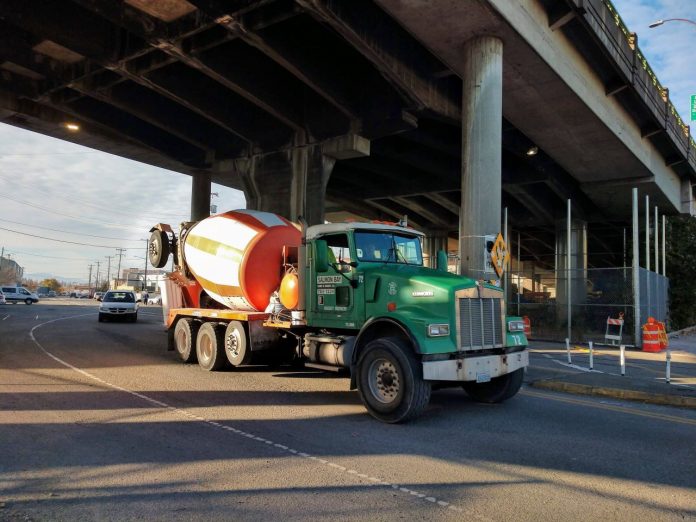
Concrete is not flowing in King County and several high-profile infrastructure projects threaten to be delayed as a result. Concrete mixer drivers are striking for higher compensation on par with other building trade unions and a health plan that lowers cost for retired members, but the six largest concrete companies have refused to meet their terms.
“We’re building a city that we’re not able to live in anymore,” picketing mixer driver Brett Gallagher said in an interview with More Perfect Union. “Inflation, the cost of living around here has gone through the roof. My local Safeway just up the hill in West Seattle they’re selling ground beef for $7.99 a pound.”
Although the companies claim to be be negotiating with workers, they had refused to meet with Teamsters union representatives during most of the two-month strike and demanded a federal mediator. Some companies have turned to strikebreakers to deliver concrete to projects.
The two sides finally returned to mediation on Thursday, KIRO reported — albeit with the same mediator that failed to reach a deal in January: Beth Schindler, regional director of field operations with Federal Mediation and Conciliation Service. But with construction delays and layoffs on major infrastructure projects piling up, the pressure to reach a deal is higher, which may lead to a resolution this time around.
Mayor Bruce Harrell mentioned the concrete drivers strike in his state of the city speech earlier this month, but seemed to place equal blame on both striking workers and the companies refusing to bargain with them. Reopening the West Seattle Bridge and keeping other Seattle Department of Transportation (SDOT) projects on schedule appears to be a driving concern — less so the wellbeing of workers.
“The [West Seattle] Bridge remains one of the City’s most pressing priorities, even, as I announced last week, that the re-opening schedule is threatened by the ongoing concrete work stoppage,” Harrell said. “So many of our projects involve concrete – from our Waterfront Seattle Program to our Ship Canal Water Quality Control project, and just about every major SDOT priority, including the Madison Rapid Ride Line, and curb ramp and sidewalk installation improvements.”
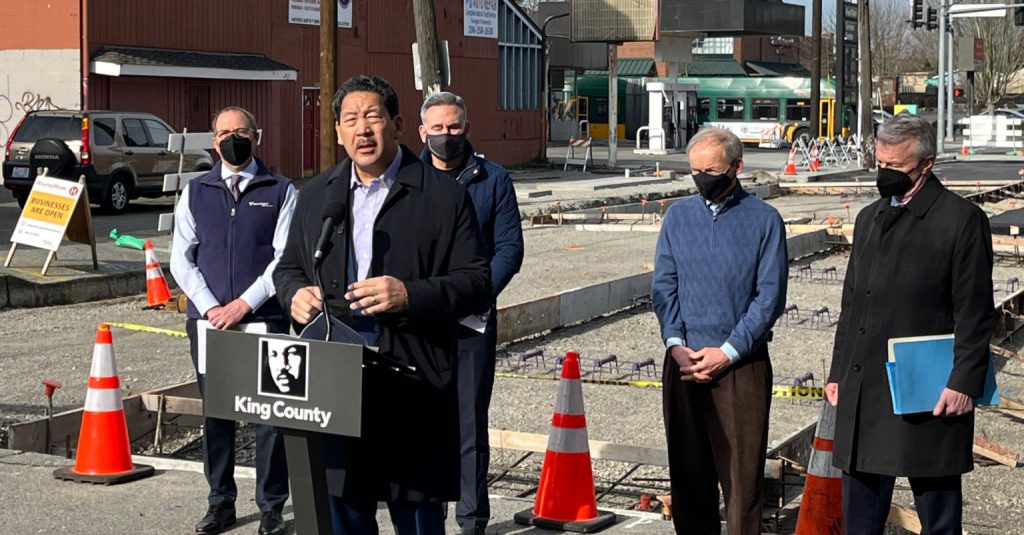
The February 20th deadline that Harrell set has come and went, with no resolution in sight. The Mayor welcomed news Thursday of resumed mediation.
“The Mayor was very pleased to see the two sides return to mediation yesterday and hopes they will urgently reach a fair and just agreement,” spokesperson Jaime Housen said in an email Friday morning. “The mayor and staff have been in frequent communication with Teamsters throughout the strike.”
SDOT’s West Seattle Bridge Project Director Heather Marx appears to walking back the significance of the Mayor’s deadline a bit. The City set mid-2022 as the reopening the West Seattle Bridge when Mayor Jenny Durkan chose the repair rather than replace option for the cracked and sagging bridge, which has been closed since March 2020.
“It’s not a situation where every day past the 20th means another day on the end of the schedule,” Marx told KIRO’s Chris Sullivan. “There still may be things we can do to skinny it up.”
Marx said the City and its contractor haven’t had to lay any workers off yet because they’ve been able to shift attention over to the Lower Spokane Street Bridge, which also needs repairs and is part of the same contract.
Construction stoppage could spread
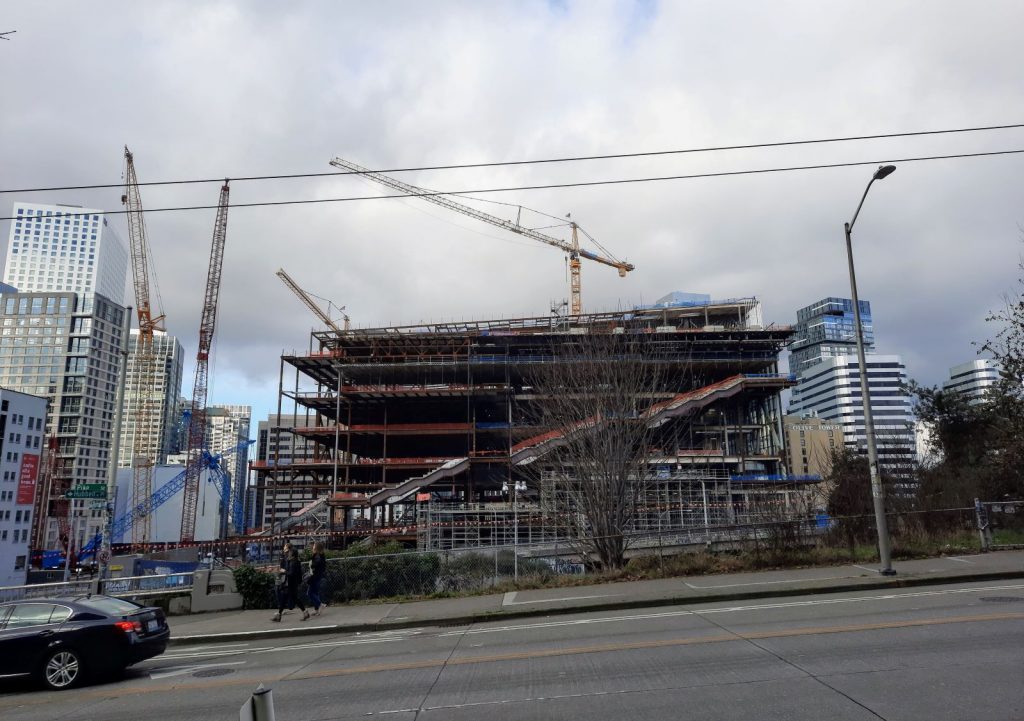
Other projects haven’t been so lucky. Some highrise construction sites have had to shutter without concrete to support their continued rise and lay their decks. Among them is a new office tower in the Meta (a.k.a. Facebook) campus in Bellevue’s Spring District and Microsoft’s big campus renovation in Redmond. Sound Transit’s light rail construction projects across the region — including East Link, Downtown Redmond, Federal Way Link, and Lynnwood Link — are also affected with some work paused due to the concrete stoppage, as are the I-405 freeway expansion in the Eastside and the Washington State Convention Center Addition, which had already faced financing issues as its budget has ballooned to $1.9 billion. The new Seattle Aquarium is at risk of delay, as are other elements of the Seattle Waterfront overhaul.
“The inability to get concrete to Sound Transit job sites is causing serious delays to needed transit expansions and pushing construction workers into unemployment,” said Sound Transit CEO Peter Rogoff in a statement on February 9th. “On Sound Transit’s projects alone, we’ve missed more than 2,200 deliveries, equivalent to a line of concrete trucks more than 14.5 miles long. Our contractors have laid off more than 200 workers, and another 165 jobs are threatened. It’s critical that the parties to this dispute work together to negotiate a resolution.”
Other building trades workers have been impacted and laid off as some construction projects have ground to halt as a result of lacking concrete to lay their foundations or pour their decks so towers can rise. The concrete stoppage could continue to affect more trades and eventually the whole construction industry as it lingers.
“When concrete isn’t delivered, it is a domino effect,” picketing mixer driver Jerry Pylman said in a More Perfect Union interview. “The steelworkers ran out of work first. Then it will be the carpenters. Obviously, the concrete finishers, and it will trickle on down the line. When you can’t pour another deck on a highrise, they can’t keep going up.”
The livelihoods of many families is on the line, and a slowdown in housing construction could in turn exacerbate the housing affordability crisis. Bellwether and Plymouth Housing’s affordable highrise apartment project in First Hill was among the projects stalled out and facing a delayed opening, Bill Ketcham, general manager with Turner Construction, said in a KUOW interview. Turner is the largest domestic contractor in the country and pulled in $14.4 billion in revenue in 2020.
It’s astounding that Seattle’s $23 billion industry can’t find the money to compensate approximately 330 concrete truck drivers to their liking and get their projects moving again. Meeting worker demands would be a drop in the bucket for projects that cost in the hundreds of million, but perhaps it’s the symbol and potential for a domino effect to other trades that is driving the companies’ obstinacy. In addition to raising the standard of living for fellow construction workers in the region, some picketing truck drivers said they had common cause with workers across the country, from Starbucks baristas to REI clerks to Amazon warehouse workers. That rising worker solidarity could be driving the defensive posture.
A few dollars more per hour in compensation for mixer drivers would likely be easy enough to weather, but if that goes industry-wide, the bottom line of the contractors, developers, and financers could be affected. And builders are already feeling squeezed by skyrocketing prices for construction materials, and may look at labor as a cost driver where they have to hold the line.
Commercial contractor Mortenson released its largest ever increase to its regional construction cost index earlier this month, Puget Sound Business Journal’s Marc Stiles reported.
“Costs rose 4.3% in Seattle during the quarter and over the full year they went up 26.1%. Nationally, costs increased 2.9% in Q4 and 21.5% in 2021,” Stiles reported. “The reasons for the increases are well known. They include manufacturing issues, the squeezed supply chain and raw material shortages. Still, the numbers surprise: lumber prices up 78% over the past year, copper up 67% and PVC pipe up 105%.”
Add to that a labor shortage and it’s a recipe for a disaster for those hoping to build housing and infrastructure in an economical manner. Construction employment in the Seattle metro totaled 26,800 in December, which is 800 fewer workers than the end of 2020, Stiles wrote. “Labor availability will continue to be a top concern in 2022,” the Mortenson report added.
Playing hard ball with labor during a labor shortage hardly seems the wisest strategy. In a region as booming as Seattle, the construction sector should be growing rather than stagnant and one frequently cited factor for the shortage of construction workers is the sky-high cost of housing in the region.
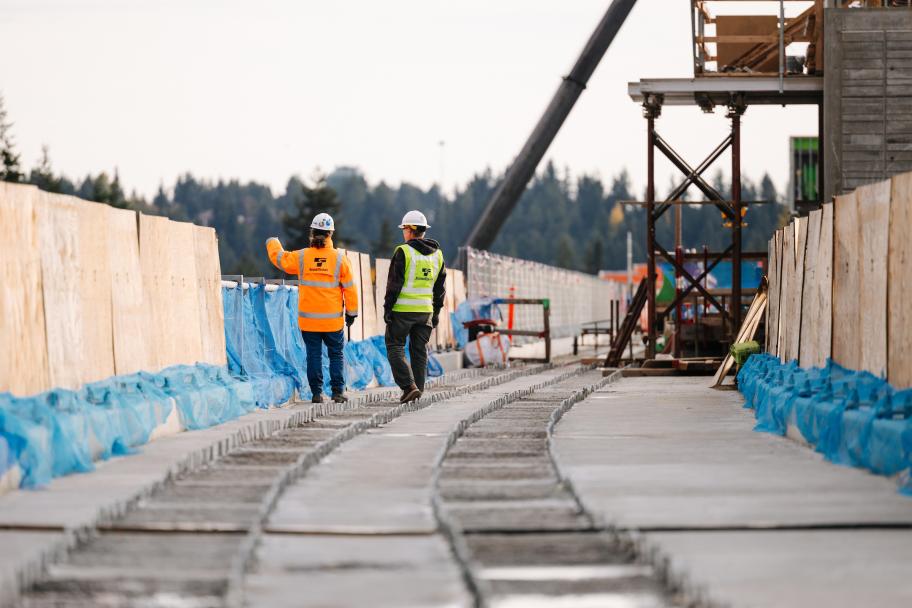
Concrete mixer driver is a highly-skilled job that requires not just driving the truck, but also carefully managing and calibrating the mixer during the process so the concrete arrives at the site ready to pour in accordance with the exact specifications of the particular project, as noted in a KUOW’s in-depth report on the strike. This is not a throwaway position in the construction ecosystem easily filled by strikebreakers. Nonetheless, concrete companies appear largely unwilling to meet their demands.
“I have been clear that business and labor must return to the bargaining table and reach a fair agreement,” Harrell continued. “This conflict continues to dangerously escalate in a way that helps no one and hurts everyone. To make my commitment to a just resolution clear, I offer this room to the workers and businesses – any time – as a place to come together and resolve their disagreement.”
While offering city hall as a meeting place was a showy gesture, the main stumbling block appears to be concrete companies’ unwillingness to come to the table and make additional concessions, rather simply lacking a venue.
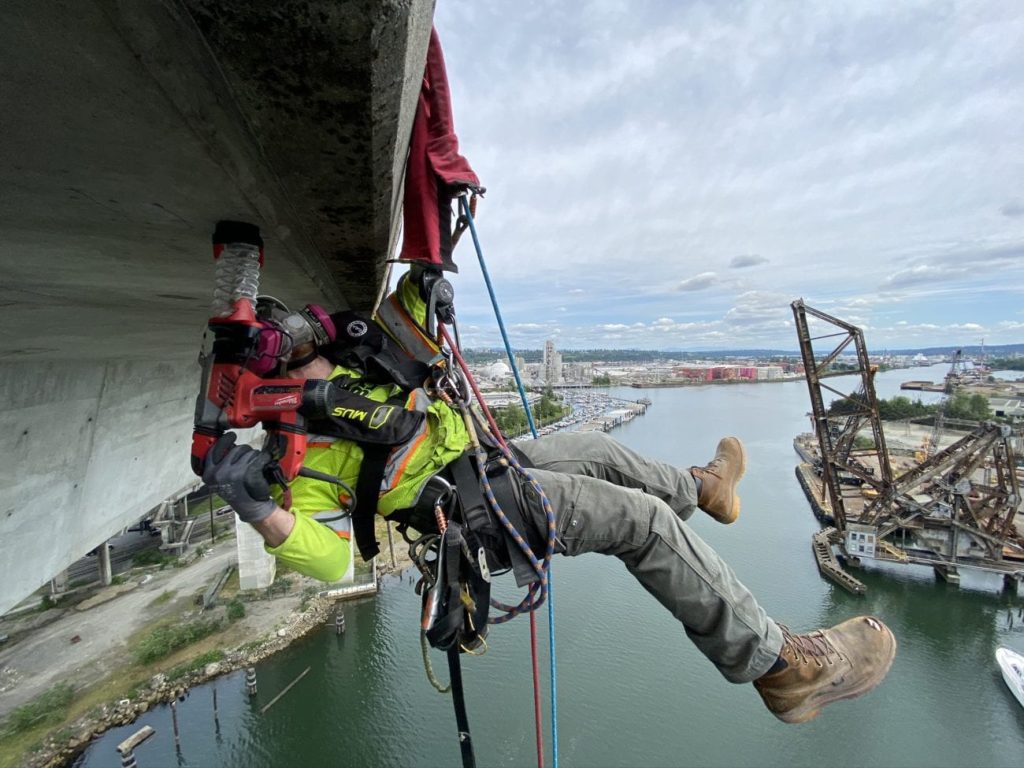
Likewise, King County Executive Dow Constantine sought to hasten a resolution to the labor dispute by guaranteeing about $30 million of County contracts to the first concrete company to reach a collective bargaining agreement with its truck drivers, as he announced at the February 9th press conference. But that amount of money isn’t that persuasive in a $23 billion industry and none of the companies have taken him up as of yet.
The West Seattle Bridge will need about 25 loads of specialized concrete delivered to continue cost tensioning work, which requires large concrete blocks to anchor cables. “In order to attach the steel to the concrete, we need to have anchoring at either end, and this concrete is going to have to hold a million pounds of pressure per each tendon,” Marx said. Mayor Harrell wants the bridge done, but breaking the strike with less skilled workers could jeopardize the integrity of the structure. Getting concrete shipped in from farther afield is also untenable because concrete can only be in the mixer about 90 minutes max before it loses strength and becomes useless.
Teamsters say the contract offer isn’t fair
Jamie Fleming, communication director for Teamsters Local 174, said the companies’ offer simply didn’t come close to meeting worker demands, which is why the vote was nearly unanimous to reject it.
“The company’s offer does not keep up with either inflation or the other contracts ratified by other Building Trades Unions, and even more critical to this discussion, it was rejected by a vote of 212-1 by our members,” Fleming said in an email. “So the companies have been told in no uncertain terms that their offer is not good enough and they will need to improve it if they want to reach a contract. Instead of doing that, they have stonewalled, filed lawsuits, and tried to find ways to run concrete without our skilled and trained members.”
Teamsters 174 said the contract offer was not competitive and their members are demanding a package that is on par with other building trade unions. The top pay rate for mixer drivers is about $37 per hour, which is well behind other building trades, according to the Teamsters.
“Our biggest priorities in a new contract would be 1) to not fall farther behind the economic package of other Building Trades Unions, and 2) to upgrade to a cheaper retirees’ medical plan for our members, which is the same plan they already enjoy but dramatically lowers out-of-pocket costs for retired Teamsters,” Fleming said. “This new plan would cost employers a mere $0.46/hour, but they categorically refuse to agree and will not explain why not.”
Picketing Teamsters noted they worked straight through the pandemic despite the risk and they had hoped that their employers would take care of them now and make sure they have good healthcare, fair compensation, and “respect.”
“The working class, blue collar American deserves to be treated with respect,” Gallagher told More Perfect Union. “We’re not meant to just go to work, go home, and die. We have lives to live. That’s what we’re fighting for here.”
Reaching a deal
A group of over 30 major contractors, developers and subcontractors backed a cooling off period that would see a temporary end to the strike while the companies and Teamsters bargain, perhaps with the help of a mediator via the Federal Mediation and Conciliation Service.
“We respect the right of the parties to bargain,” Turner’s Ketcham said in a statement. “But the standstill has now shut down dozens of public and private construction projects and thrown thousands of people out of work at a time when the pandemic has already ravaged our economy. People need to get back to work now, while negotiations continue in earnest.”
But ultimately a cooling period would offer no long-term resolution if concrete companies refuse to meet worker demands.
Four of the six concrete companies — Glacier Northwest, Stoneway Concrete (which is now owned by Gary Merlino Construction Company), Salmon Bay Sand and Gravel, and Cadman — issued a joint statement on February 15th arguing their offer was actually “generous” and competitive despite the resounding 212-1 vote against it by their workers. The two companies not signed onto that statement are CalPortland and Lehigh Cement. The four companies point to a 17.6% pay raise over three years and argue total compensation is on par with other trades. The Teamsters argues that offer does not keep up with inflation and wages still lag other building trades.
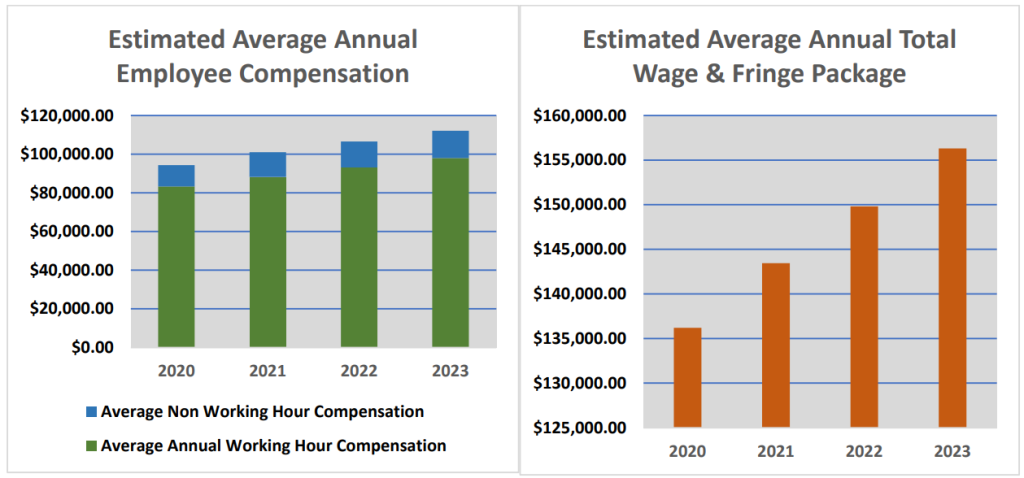
The concrete companies include their benefits package in their figures and by doing so argue mixer drivers make $150,000 in total annual compensation on average. The union stresses that annual wages are closer to $80,000 to $90,000 on average and still too low to cover Seattle living costs. Fringe benefits can’t pay skyrocketing housing costs or put food on the table. This impasse and refusal to even define compensation the same way appears to be one big reason why negotiations have dragged on so long, with first talks dating back to July.
High housing and living costs in Seattle are driving labor costs higher still which in turn is driving up housing construction costs in a vicious cycle. Getting out of this doom loop is imperative to solving the housing affordability crisis and ensuring a high quality of life for all in the region. The government will likely need to play a bigger role to ensure enough housing gets built and workers can afford to live here.
It starts one contract at a time, be it labor or social contract.
Update: This article was updated Friday morning with the statement from the Mayor’s office and news that mediation had resumed.
Doug Trumm is publisher of The Urbanist. An Urbanist writer since 2015, he dreams of pedestrian streets, bus lanes, and a mass-timber building spree to end our housing crisis. He graduated from the Evans School of Public Policy and Governance at the University of Washington in 2019. He lives in Seattle's Fremont neighborhood and loves to explore the city by foot and by bike.

